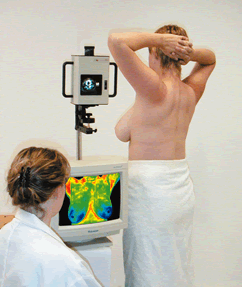The Examination Procedure
This quick and easy test starts with your medical history being taken before you partially disrobe for the scanning to be performed. When doing a breast series, this first session provides the initial portion of your baseline in developing your “thermal thumbprint”. A subsequent session in 3 months assures that the patterns remain unchanged and with these two sessions you establish your baseline. Standard region of interest exams take approximately 15 minutes and a full body 30 minutes. Your printed report is normally completed within a few days. All of your thermograms (scanned images) are kept on record and once your stable thermal pattern has been established any changes can be detected during your routine annual studies.

- Non Invasive
- No Radiation
- Painless
- No Contact with the Body
- F.D.A. Registered
Current Early Detection Guidelines
One day there may be a single method for the early detection of breast cancer. Until then, using a combination of methods will increase your chances of detecting cancer in an early state. These methods include:
- Mammography, when considered appropriate for women who are aged 50 or older.
- A regular breast examination by a health professional.
- Monthly breast self-examination.
- Annual DITI screening for women of all ages.
- Personal awareness for changes in the breasts.
- Readiness to discuss quickly any such changes with a doctor.
These guidelines should be considered along with your background and medical history.
Cell Doubling Chart

